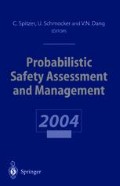Abstract
This paper shows a sample study where quantitative risk assessment of a tank containing a toxic substance was performed through IDDA method. A comparison is shown between the results obtained through IDDA analysis and the one obtained with classical QRA techniques (Recursive Operability Analysis and quantified Fault Tree directly extracted from it).
The IDDA method provides a full representation of the plant states during operations (ordinary, incidental or irregular operating conditions), as well as all the possible occurrences patterns (description of events), expressed in a set of mutually self-excluding sequences. Availability of the full set of alternative allows the complete spectrum of possible probability-consequence conditions to be used as a basis for decisions in risk reduction and control.
Access this chapter
Tax calculation will be finalised at checkout
Purchases are for personal use only
Preview
Unable to display preview. Download preview PDF.
References
Piccinini, N., Scarrone M., and Ciarambino, I., “Probabilistic analysis of transient events by an event tree directly extracted from operability analysis”, J. Loss Prev. Process Ind., 7, 1, 1994, 23–32.
Piccinini N. and Ciarambino I., “Operability analysis devoted to the development of logic trees”, Rel. Eng. Syst. Safety, 55, 1997, 227–241.
Wakefield D.J. & Epstein S., Fault Tree Linking vs. Event Tree Linking, European Conference ESREL 2002, 19-21 March 2002, Lyon, France.
Lees, F. P., Loss prevention in the process industries: hazard identification, assessment and control, Butterworth — Heinemann, Oxford, 1996.
Galvagni, R. and Clementel, S., “Risk Analysis as an instrument of design”, in “Safety Design Criteria for Industrial Plant”, M. Cumo and A. Naviglio (eds.), CRC Press, Boca Raton, 1989.
Author information
Authors and Affiliations
Editor information
Editors and Affiliations
Rights and permissions
Copyright information
© 2004 Springer-Verlag London
About this paper
Cite this paper
Demichela, M., Piccinini, N. (2004). Integrated Dynamic Decision Analysis (IDDA): an Advanced Tool for Risk Analysis. In: Spitzer, C., Schmocker, U., Dang, V.N. (eds) Probabilistic Safety Assessment and Management. Springer, London. https://doi.org/10.1007/978-0-85729-410-4_473
Download citation
DOI: https://doi.org/10.1007/978-0-85729-410-4_473
Publisher Name: Springer, London
Print ISBN: 978-1-4471-1057-6
Online ISBN: 978-0-85729-410-4
eBook Packages: Springer Book Archive

